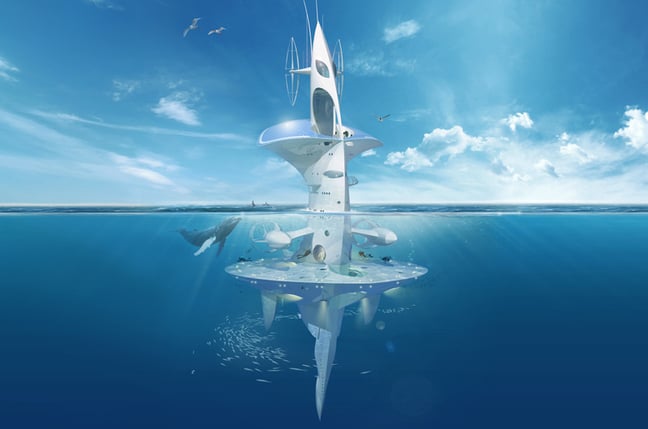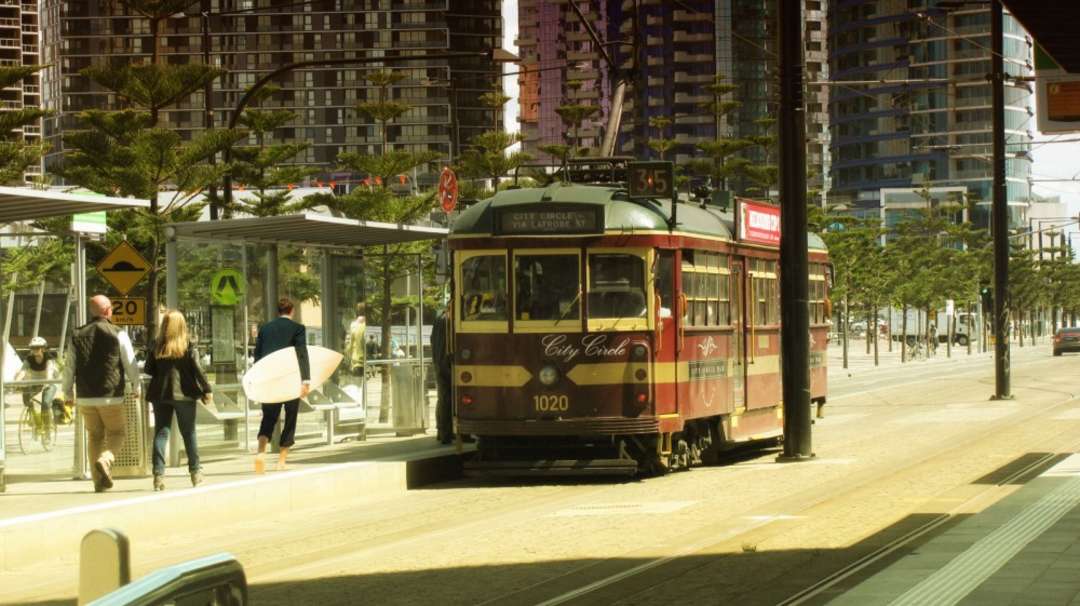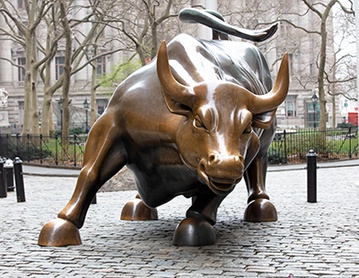Oceans have two things cities need a lot of: space and water. Solar powered water desalination would make sense. Floating happens on its own. It should be possible to build really large cities. You build one unit and scale it. Seafood would be abundant. Multi-storey farming would be an option. Beam in some internet. Water transportation is cheap. And these cities don't have to be in the middle of nowhere. They could be just 10 miles or so out. You don't have to feel cut off. You might even commute to your weekly meeting on the land. And rising sea levels don't affect ocean cities.
In the floating city concept, the "skyscraper" part would go in both directions. There is no basement, to speak of. The elevators take you to the surface. That would make for interesting living. Oceanscraper would be the word.
Large cruise ships are floating cities, but not designed to be sustainable.
These cities would generate their own electricity through solar and wind.
How about cities on the water that are not even disconnected from the land! As a way to claim more land than might be lost to rising sea levels.
The ocean is half way to Mars.
City floating on the sea could be just 3 years away
floating cities are the perfect places to experiment with new forms of government. ..... the floating city may be built in modular pieces so that city blocks and neighborhoods can be recombined to create new urban layouts. .... seasteads are loosely based on oil rigs, but with important modifications. ..... We care more about sunlight and open spaceFLOATING CITIES: IS THE OCEAN HUMANITY’S NEXT FRONTIER?
“Three-quarters of our planet Earth is covered with water, most of which may float organic cities,” Fuller explains in his book Critical Path. “Floating cities pay no rent to landlords. They are situated on the water, which they desalinate and recirculate in many useful and non-polluting ways.” ....... Fifty years on, with heavy pollution causing climate change and rising sea levels, Fuller’s floating city concept is being seriously considered as an antidote to those problems. ...... With almost 20% of the world’s population living in China, it is no surprise that the People’s Republic is one of the keenest countries to translate Fuller’s idea into a modern reality. ...... a four square mile floating city ...... Using the same technologies that CCCC used to build a 31-mile bridge between Hong Kong, Macau and Zuhai, a series of prefabricated 150m x 30m blocks would be created in a factory and floated out to site for construction. ...... The city’s infrastructure includes a cruise dock, walkways and a network of roads and canals that will be used by electric cars and submarines, keeping the island free from congestion and air pollution. ....... Recreational green spaces would be located above and below the water’s surface while farms, hatcheries and rubbish collection facilities would allow the community to produce its own food and sustainably dispose of waste. ...... “The project offered an opportunity to develop a new urban nucleus of world-class residential, commercial and cultural facilities, as well as to promote a zero-carbon, energy-efficient and self-sufficient city” ....... The Seasteading Institute aims to take the idea of floating cities even further, creating communities that have political autonomy whilst existing under the sovereignty of a host state. They are currently in discussions with several potential host countries and are aiming to establish their first seastead by 2020. ........ the city’s base structure would be constructed out of 50m x 50m modular platforms, which will cost approximately $15m each to build. ..... “Oil platforms can withstand waves but we want to create something with a clearer connection with the water. A protective wall is one strategy we’re looking at that may help. ....... a basic structure out of expanded polystyrene (EPS) blocks. These are made up of tiny cells filled with air so are impossible to sink. ....... combining EPS with concrete to create something really solid and stable with a low centre of gravity. These foundations would then be anchored to mooring poles, allowing them to move up and down with the tide. ....... Freedom Ship International .. the proposed vessel’s superstructure would rise twenty-five stories above its broad main deck and have its own airport, banks, library, hospital, athletics facilities, casinos and warehouses catering for up to 80,000 people. ........ We’re well on the way of securing our initial target of $1bn investment funding ....... “Most of the world is covered in water but we’re still hunter-gatherers on the sea”Has the time come for floating cities?
Whereas some coastal cities will double down on sea defences, others are beginning to explore a solution that welcomes approaching tides. What if our cities themselves were to take to the seas? ...... A floating village at London's Royal Docks has the official nod, and Rotterdam has a Rijnhaven waterfront development experiment well under way. Eventually, whole neighbourhoods of water-threatened land could be given over to the seas. After decades of speculation and small-scale applications, the floating solution is finally enjoying political momentum – and serious investment. ....... You could extend an existing city like London into the water quite far before ever being seriously challenged by infrastructure issues. ..... In the 1960s, futurist Buckminster Fuller designed a floating city, Triton, for 100,000 residents ..... Fresco's floating city designs – generally gear-shaped – prescribe the use of "memory metals". Compressed into small cubes, they are easily towed out to sea, where they can be snapped back to the size of buildings. ...... Airports are particularly prime for floating: they essentially require a large platform that is close to the destination city without being intrusive. ....... The abundant wind available at sea could power turbines. Ocean thermal energy conversion could harness the temperature difference between the surface and the depths – a process that also provides fresh water as a byproduct. DeltaSync even envisions residents cultivating aquaculture in lieu of gardens, manufacturing their food requirements from nutrients found in upwellings at the edge of continental shelves. A so-called "Blue Revolution" in aquaculture would be required for the oceans to provide this level of sustenance. (Even without cities at sea, though, ocean harvesting may be our best hope, as land-based agriculture faces salinated soils and a critical phosphorus shortage.) ........ Freedom Ship would essentially be a mile-long flat-bottomed barge with a high-rise building on top. Weighing 3 million tonnes and with a top speed of 10 knots, the floating city would circle the globe every three years, stopping 12 miles offshore at each port for a week at a time. High-speed ferries would connect the 40,000 residents and 20,000 crew to the mainland and bring back visitors. "We won't just be visiting those countries," says Freedom Ship director and executive vice president Roger Gooch. "We anticipate those countries visiting us." ....... Freedom Ship's size – and its $11bn price tag – gives it a credibility problem ....... The thriving Hong Kong sampan-dwelling community of Causeway Bay was not to last. There was no garbage or sewerage treatment system, and fire constantly threatened the wooden structures. Breakwaters that made up the typhoon shelter also limited water circulation, leaving pollution to accumulate in the harbour. The wastewater from the moored vessels combined with leaked sewer discharge and storm drain runoff to create unsanitary living conditions. .......
When Tanka families were offered public housing on land in the 1980s, most chose this option.
...... Untethering from land seems a big moment for a floating city, akin to blasting off to colonise another planet. To reject our ancestral habitat to this degree seems like hubris. How could a group of people survive alone among the waves? ..... But it is a fallacy to imagine we're self-sustaining even in our land-based communities. Many of our essential goods arrive by tanker anyway – a sea-based location would be all the more convenient. Far from impractical utopias, floating cities could be every bit as integrated into global society as the ones we already have on land.









































